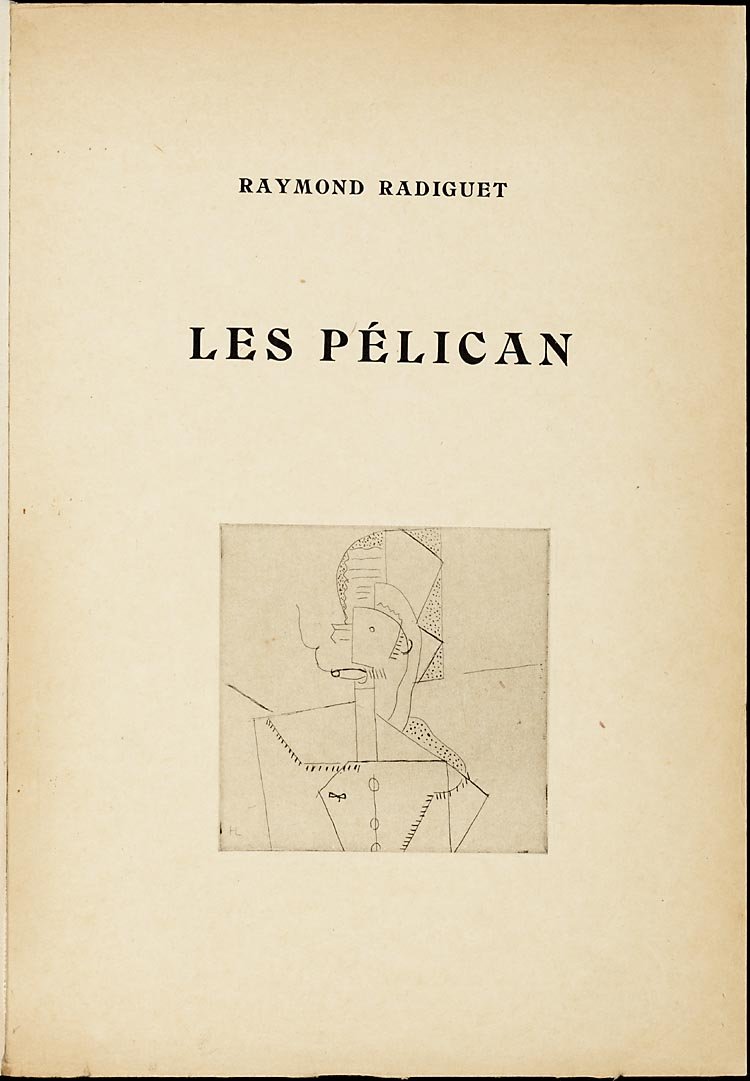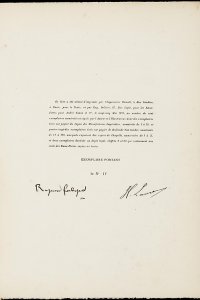Les Pélican : pièce en deux actes
Year: 1921
Author: Raymond Radiguet (1903 - 1923)
Artist: Henri Laurens (1885 - 1954)
Publisher: Éditions de la Galerie Simon
Clear connection
The text of Les Pélican was published in the year of its premiere by Galerie Simon, which was managed by Daniel-Henry Kahnweiler (1884-1979), who had worked as a publisher since 1908. Heasked cubist sculptor Henri Laurens to illustrate the book for this publication. Radiguet had mentioned the names of Juan Gris and Fernand Léger, but the publisher saw aclear connection between Laurens and Radiguet. Les Pélican is one of the few books illustrated by Laurens, and also one of the most famous. It is- contrary to what many reference books say- not his first design for a book; in 1915 he had already designed the front cover (for only three copies) of the collection Poèmes en prose by Laurens' friend Pierre Reverdy in 1915. Two years later he illustrated Spirales by Belgian poet Paul Dermée, which was probably published by Reverdy. Laurens produced seven copper engravings for Les Pélican in May 1921, which were printed on the front cover, between the text, and on separate pages. They are mostly portraits of the characters.
Kahnweiler always employed the same working methods for his books: the size was between 28 and 48 pages, the edition was made up of 112 copies, ten of which were printed on Japanese paper, and ninety on Dutch Van Gelder (for retail). On top of that, twelve copies were printed that were never intended for retail. Two of these twelve copies were saved in the publisher's archive, and ten were intended for the writer and the artist. The same holds true for Les Pélican. Copy number IV is part of the Koopman Collection, of the ten copies for the book's creators, bearing the autographs of Henri Laurens and Raymond Radiguet.
Bibliographical description
Description: Les Pélican : pièce en deux actes / Raymond Radiguet ; ill. d'eaux-fortes par Henri Laurens. - Paris: Éditions de la Galerie Simon, 1921. - [28] p. : ill.. ; 33 cm
Printer: Birault (tekst) Eug. Delâtre (Parijs) (etsen)
Edition: 112 copies
This copy: Number IV of 100 on Dutch Van Gelder
Bookbinder: Pierre J.M. Thielen
Note: Signed by author and artist
Bibliography: Bénézit 8-329 ; Carteret IV-330 ; Castleman 174 ; Hogben 62 ; Johnson 27 ; Mahé III-200 ; Monod 9448
Shelfmark: KW Koopm A 551
References
- Pierre Assouline, L'homme de l'art: D.-H. Kahnweiler (1884-1979). Paris, Balland, 1988
- Anisabelle Berès, Michel Arveiller, Henri Laurens 1885-1954. Paris, Galerie Berès, 2004
- Paul van Capelleveen, Sophie Ham, Jordy Joubij, Voices and visions. The Koopman Collection and the Art of the French Book. The Hague, Koninklijke Bibliotheek, National Library of the Netherlands; Zwolle, Waanders, 2009
- Paul van Capelleveen, Sophie Ham, Jordy Joubij, Voix et visions. La Collection Koopman et l'Art du Livre français. La Haye, Koninklijke Bibliotheek, Bibliothèque nationale des Pays-Bas; Zwolle, Waanders, 2009
- Margareth Crosland, Raymond Radiguet: A biographical study with selections from his work. Peter Owen, London, 1976
- Henri Laurens, 1885-1954. Fribourg, Office du Livre, 1985
- Henri Laurens (1885-1954): Skulpturen, Collagen, Zeichnungen, Aquarelle, Druckgraphik. Bestandskatalog und Ausstellungskatalog, Œuvreverzeichnis der Druckgraphik. Hannover, Sprengel Museum, 1985
- Monique Nemer, Raymond Radiguet. Paris, Fayard, 2002
- Chloé Radiguet, Julien Cendres, Raymond Radiguet: un jeune homme sérieux dans les années folles. Paris, Mille et une nuits, 2003



![Les Pélican, pagina [21] met ets door Henri Laurens](/sites/default/files/styles/galerie/public/images/les-pelican-p21.jpg?h=683daa2f&itok=fKuEpP9s)
![Les Pélican, pagina [5] met tekst en ets door Henri Laurens](/sites/default/files/styles/galerie/public/images/les-pelican-p5.jpg?h=683daa2f&itok=HyHlb8vN)
![Les Pélican, pagina [7]](/sites/default/files/styles/galerie/public/images/les-pelican-p7.jpg?h=5ec3550a&itok=x6-RR0A6)
